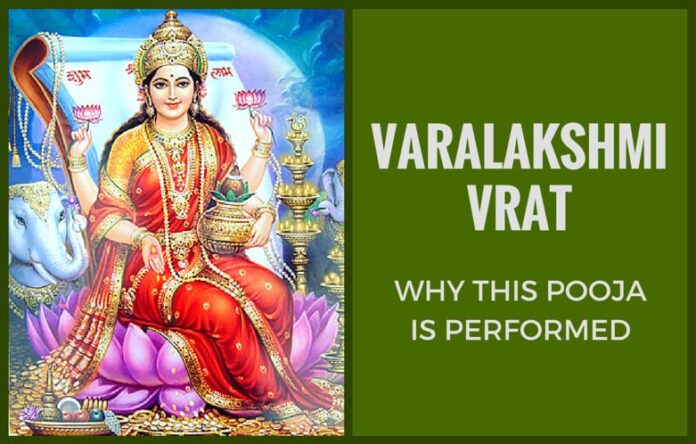
Latha Iyer
India is a land of festivals and with so many Gods and Goddesses that doesn’t come as a surprise. Like the Hindu male trinity of Brahma, Vishnu and Shiva; their respective consorts Saraswati, Lakshmi and Parvati are among the most important deities in Hinduism. Several festivals are celebrated to appease the deities and gain their favor. One such festival which falls in the Hindu month of Shravan (Tamil month: Aadi or Avani and July-August as per the English calendar) is the Varalakshmi Vratham. It is conducted on the Friday before Poornima (Full moon). Friday is an auspicious day for the Goddess because She incarnated on a Friday. This festival is mainly celebrated in the southern states of Karnataka, Andhra Pradesh, Telangana and parts of Tamil Nadu (particularly North Arcot and Thirunelveli). While in the rest of the states it is celebrated in almost all households, in Tamil Nadu it is hereditary and is handed down from mother-in-law to daughter-in-law.
This pooja is done to propitiate the Goddess of wealth Lakshmi Devi. Vara is a Sanskrit word meaning boon and it is believed that the Goddess will fulfill one’s desires. This pooja is done by married ladies known as sumangalis for the well being of the entire family in general and their husbands in particular.
Pooja vidhi:
A mandap or pandal is constructed within which a plate of raw rice is kept. On the plate a silver pot filled with rice and whose mouth is covered with a coconut and a bunch of mango leaves is placed. A prototype of the Goddess is then kept on this pot and decorated with dress, jewels and flowers. The pandal is decorated with plantains. At the time of the pooja the Goddess is brought into the house ceremoniously indicating that the family members are welcoming her into their homes and seeking her blessings.
The main ceremony consists of an elaborate pooja beginning with salutations to Lord Ganesha, the remover of obstacles. This is followed by the recitation of shlokas dedicated to Goddess Lakshmi. Once prayers are offered to the Kalasa (pot), the 108 names of the Goddess are chanted after which a yellow thread is tied to the wrists of all the female members of the family. The pooja is concluded by offering various food items as Prasad and singing the aarti. In the evening, haldi-kumkum is distributed to all ladies and girls in the neighborhood.
Story associated with the Vrat:
It is said that Goddess Lakshmi is pleased with those who perform this vrat and blesses them with health, wealth and prosperity. The story of Shyamabala proves this.
There once lived a benevolent king Bhadrashravas who was a great devotee of Lord Vishnu. His queen was Surachandira and the couple had a daughter named Shyamabala. When the girl came of age they got her married to the emperor Maladharan.
Once Lakshmi Devi appeared in the form of an old married woman to the palace of Bhadrashravas and sought an audience with the queen. The old woman then explained the importance of the Varalakshmi vrat and asked the queen to undertake it. However, Surachandira in her arrogance insulted the old lady and drove her away. But Shyamabala not only welcomed the old woman but also learnt about the vrat from her. She followed the instructions given by the Goddess meticulously and conducted the pooja with utmost devotion. Pleased by her devotion the Goddess blessed her with ample wealth. Her parents, on the other hand, lost all their wealth because they had turned away the Goddess. Shyamabala felt sad for her parents and asked her mother to undertake the Varalakshmi Vrat to regain lost riches. Surachandira followed suit and became prosperous again.
Another story, which finds mention in the Skanda Purana, is that of the pious Brahmin lady Charumathi. It is said that Goddess Lakshmi appeared in her dream and asked her to perform the Varalakshmi pooja. Following this Charumathi along with the women of the village performed the pooja with utmost devotion and gained the favor of the Goddess.
The delicacies:
Food is an integral part of any Indian celebration and the Varalakshmi pooja is no exception. The menu may vary a little from house to house depending on the family tradition but most of the items of Prasad or offering are the same. The main preparations include idli, neyappams (appams made out of a mixture of ground rice, jaggery and coconut), modaks, chakarai pongal (sweet pongal), vadas and sundal (spicy pulses salad), cooked rice, Dal etc.
This year Varalakshmi pooja falls on 28th August.
- Revering our rivers: a story of revival - August 22, 2016
- The saga of the elephant headed God – Sripuranthan Ganesha - July 22, 2016
- Ghar Wapsi of Chola bronzes - June 20, 2016








Good article.we should use the word de/devi instead of God which has specific meaning in xnity or abrahamic religion in general
Sorry for the delayed response. I will surely keep your advice in mind and incorporate your suggestion in my future posts.
Very well composed. Please add an image.